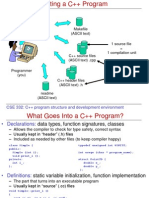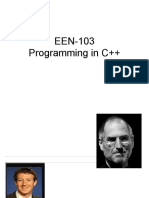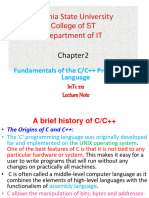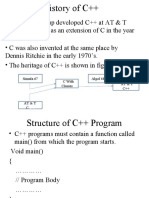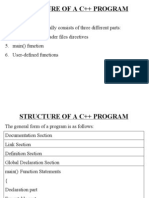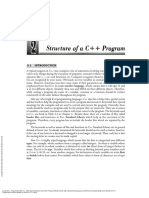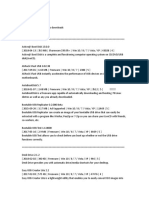0 ratings0% found this document useful (0 votes)
72 viewsC++ Programs
The document discusses the key components of a C++ program: declarations in header files, definitions in source files, and directives that provide instructions to the compiler. It then provides a simple "hello world" example to demonstrate these components, including the #include directive to import the iostream header, the using namespace std directive, the main() function definition, outputting text to cout, and returning 0 at the end.
Uploaded by
amolia2004Copyright
© © All Rights Reserved
Available Formats
Download as PPT, PDF, TXT or read online on Scribd
0 ratings0% found this document useful (0 votes)
72 viewsC++ Programs
The document discusses the key components of a C++ program: declarations in header files, definitions in source files, and directives that provide instructions to the compiler. It then provides a simple "hello world" example to demonstrate these components, including the #include directive to import the iostream header, the using namespace std directive, the main() function definition, outputting text to cout, and returning 0 at the end.
Uploaded by
amolia2004Copyright
© © All Rights Reserved
Available Formats
Download as PPT, PDF, TXT or read online on Scribd
You are on page 1/ 8
C++ Program Structure (and tools)
Today we’ll talk generally about C++
development (plus a few platform specifics)
• We’ll develop, submit, and grade code in Windows
• It’s also helpful to become familiar with Linux
– E.g., on shell.cec.wustl.edu
• For example, running code through two different
compilers can catch a lot more “easy to make” errors
CSE 332: C++ program structure and development environment
What Goes Into a C++ Program?
• Declarations: data types, function signatures, classes
– Allows the compiler to check for type safety, correct syntax
– Usually kept in “header” (.h) files
– Included as needed by other files (to keep compiler happy)
class Simple { typedef unsigned int UINT32;
public:
Simple (int i); int usage (char * program_name);
void print_i ();
private: struct Point2D {
int i_; double x_;
}; double y_;
};
• Definitions: static variable initialization, function implementation
– The part that turns into an executable program
– Usually kept in “source” (.cpp) files
void Simple::print_i ()
{
cout << “i_ is ” << i_ << endl;
}
• Directives: tell compiler (or precompiler) to do something
CSE 332: C++ program structure and development environment
A Very Simple C++ Program
#include <iostream> // precompiler directive
using namespace std; // compiler directive
// definition of function named “main”
int main (int, char *[])
{
cout << “hello, world!” << endl;
return 0;
}
CSE 332: C++ program structure and development environment
What is #include <iostream> ?
• #include tells the precompiler to include a file
• Usually, we include header files
– Contain declarations of structs, classes, functions
• Sometimes we include template definitions
– Varies from compiler to compiler
– Advanced topic we’ll cover later in the semester
• <iostream> is the C++ label for a standard
header file for input and output streams
CSE 332: C++ program structure and development environment
What is using namespace std; ?
• The using directive tells the compiler to include
code from libraries that have separate namespaces
– Similar idea to “packages” in other languages
• C++ provides a namespace for its standard library
– Called the “standard namespace” (written as std)
– cout, cin, and cerr standard iostreams, and much more
• Namespaces reduce collisions between symbols
– Rely on the :: scoping operator to match symbols to them
– If another library with namespace mylib defined cout we
could say std::cout vs. mylib::cout
• Can also apply using more selectively:
– E.g., just using std::cout
CSE 332: C++ program structure and development environment
What is int main (int, char*[]) { ... } ?
• Defines the main function of any C++ program
• Who calls main?
– The runtime environment, specifically a function often called
something like crt0 or crtexe
• What about the stuff in parentheses?
– A list of types of the input arguments to function main
– With the function name, makes up its signature
– Since this version of main ignores any inputs, we leave off
names of the input variables, and only give their types
• What about the stuff in braces?
– It’s the body of function main, its definition
CSE 332: C++ program structure and development environment
What’s cout << “hello, world!” << endl; ?
• Uses the standard output iostream, named cout
– For standard input, use cin
– For standard error, use cerr
• << is an operator for inserting into the stream
– A member operator of the ostream class
– Returns a reference to stream on which its called
– Can be applied repeatedly to references left-to-right
• “hello, world!” is a C-style string
– A 14-postion character array terminated by ‘\0’
• endl is an iostream manipulator
– Ends the line, by inserting end-of-line character(s)
– Also flushes the stream
CSE 332: C++ program structure and development environment
What about return 0; ?
• The main function should return an integer
– By convention it should return 0 for success
– And a non-zero value to indicate failure
• The program should not exit any other way
– Letting an exception propagate uncaught
– Dividing by zero
– Dereferencing a null pointer
– Accessing memory not owned by the program
• Indexing an array “out of range” can do this
• Dereferencing a “stray” pointer can do this
CSE 332: C++ program structure and development environment
You might also like
- Download Designing Data Intensive Applications The Big Ideas Behind Reliable Scalable and Maintainable Systems Martin Kleppmann ebook All Chapters PDF75% (4)Download Designing Data Intensive Applications The Big Ideas Behind Reliable Scalable and Maintainable Systems Martin Kleppmann ebook All Chapters PDF61 pages
- Today We'll Talk Generally About C++ Development (Plus A Few Platform Specifics)No ratings yetToday We'll Talk Generally About C++ Development (Plus A Few Platform Specifics)15 pages
- Today We'll Talk Generally About C++ Development (Plus A Few Platform Specifics)No ratings yetToday We'll Talk Generally About C++ Development (Plus A Few Platform Specifics)15 pages
- Eclipse Visual Studio: Editor Makefile (ASCII Text)No ratings yetEclipse Visual Studio: Editor Makefile (ASCII Text)14 pages
- C++ Programming II: Compiled by Mr. Abunu TNo ratings yetC++ Programming II: Compiled by Mr. Abunu T85 pages
- Algorithm & Computing: Lab # 1 DE-32 DCENo ratings yetAlgorithm & Computing: Lab # 1 DE-32 DCE18 pages
- Int, Long, Short, Char (Signed, Integer Division)No ratings yetInt, Long, Short, Char (Signed, Integer Division)17 pages
- CS-323 Programming Fundamentals 4 (3-2) CS-323 Programming Fundamentals 4 (3-2)No ratings yetCS-323 Programming Fundamentals 4 (3-2) CS-323 Programming Fundamentals 4 (3-2)16 pages
- Chapter - 2 - Fundamentals of C++ Programming100% (2)Chapter - 2 - Fundamentals of C++ Programming16 pages
- CP1 - Unit 2 - C ProgLag and Its StructureNo ratings yetCP1 - Unit 2 - C ProgLag and Its Structure10 pages
- Cs 103 Computer System and Programming: Chapter 02: C++ Programming BasicsNo ratings yetCs 103 Computer System and Programming: Chapter 02: C++ Programming Basics56 pages
- Lecture 1 - Introduction and Structure of A ProgramNo ratings yetLecture 1 - Introduction and Structure of A Program25 pages
- Chapter 2 Fundamentals of Programming22222222No ratings yetChapter 2 Fundamentals of Programming2222222261 pages
- Introducing C Plus Plus - Lecture NotesNo ratings yetIntroducing C Plus Plus - Lecture Notes21 pages
- 2003 Prentice Hall, Inc. All Rights ReservedNo ratings yet2003 Prentice Hall, Inc. All Rights Reserved34 pages
- Programming With C++ - (Chapter 2. Structure of A C++ Program)No ratings yetProgramming With C++ - (Chapter 2. Structure of A C++ Program)26 pages
- Use Case: Inbound From Purchase Order - Process Flow100% (1)Use Case: Inbound From Purchase Order - Process Flow2 pages
- Avaya CTI Adapter - Salesforce - Com Integration Installation and Configuration GuideNo ratings yetAvaya CTI Adapter - Salesforce - Com Integration Installation and Configuration Guide42 pages
- Symantec Netbackup™ Security and Encryption Guide: Unix, Windows, and LinuxNo ratings yetSymantec Netbackup™ Security and Encryption Guide: Unix, Windows, and Linux353 pages
- Fundamentals of Web Development (Lesson 3)No ratings yetFundamentals of Web Development (Lesson 3)16 pages
- Ix Computer Preparation Paper 2025 - Malik GroupNo ratings yetIx Computer Preparation Paper 2025 - Malik Group2 pages
- Microsoft Certification Poster (Digital)No ratings yetMicrosoft Certification Poster (Digital)1 page
- Build Modern Web Applications With HTML5, CSS3 and JavaScriptNo ratings yetBuild Modern Web Applications With HTML5, CSS3 and JavaScript55 pages
- 3.1.2.7 Lab Getting Familiar With The Linux Shell ILMNo ratings yet3.1.2.7 Lab Getting Familiar With The Linux Shell ILM9 pages
- SharePoint 2013 and InfoPath 2013 - Creating Web Enabled FormsNo ratings yetSharePoint 2013 and InfoPath 2013 - Creating Web Enabled Forms15 pages
- Telecharger 38 Dictionnaires Et Recueils de Correspondance Crack50% (2)Telecharger 38 Dictionnaires Et Recueils de Correspondance Crack2 pages
- 1.1.2.6 Lab - Learning The Details of AttacksNo ratings yet1.1.2.6 Lab - Learning The Details of Attacks3 pages
- Scilab Image and Video Processing Toolbox Sivp-doc-2006.EnNo ratings yetScilab Image and Video Processing Toolbox Sivp-doc-2006.En18 pages
- Cobol (Common Business Oriented Language)No ratings yetCobol (Common Business Oriented Language)38 pages
- Download Designing Data Intensive Applications The Big Ideas Behind Reliable Scalable and Maintainable Systems Martin Kleppmann ebook All Chapters PDFDownload Designing Data Intensive Applications The Big Ideas Behind Reliable Scalable and Maintainable Systems Martin Kleppmann ebook All Chapters PDF
- Today We'll Talk Generally About C++ Development (Plus A Few Platform Specifics)Today We'll Talk Generally About C++ Development (Plus A Few Platform Specifics)
- Today We'll Talk Generally About C++ Development (Plus A Few Platform Specifics)Today We'll Talk Generally About C++ Development (Plus A Few Platform Specifics)
- Eclipse Visual Studio: Editor Makefile (ASCII Text)Eclipse Visual Studio: Editor Makefile (ASCII Text)
- CS-323 Programming Fundamentals 4 (3-2) CS-323 Programming Fundamentals 4 (3-2)CS-323 Programming Fundamentals 4 (3-2) CS-323 Programming Fundamentals 4 (3-2)
- Cs 103 Computer System and Programming: Chapter 02: C++ Programming BasicsCs 103 Computer System and Programming: Chapter 02: C++ Programming Basics
- Lecture 1 - Introduction and Structure of A ProgramLecture 1 - Introduction and Structure of A Program
- Programming With C++ - (Chapter 2. Structure of A C++ Program)Programming With C++ - (Chapter 2. Structure of A C++ Program)
- Use Case: Inbound From Purchase Order - Process FlowUse Case: Inbound From Purchase Order - Process Flow
- Avaya CTI Adapter - Salesforce - Com Integration Installation and Configuration GuideAvaya CTI Adapter - Salesforce - Com Integration Installation and Configuration Guide
- Symantec Netbackup™ Security and Encryption Guide: Unix, Windows, and LinuxSymantec Netbackup™ Security and Encryption Guide: Unix, Windows, and Linux
- Build Modern Web Applications With HTML5, CSS3 and JavaScriptBuild Modern Web Applications With HTML5, CSS3 and JavaScript
- 3.1.2.7 Lab Getting Familiar With The Linux Shell ILM3.1.2.7 Lab Getting Familiar With The Linux Shell ILM
- SharePoint 2013 and InfoPath 2013 - Creating Web Enabled FormsSharePoint 2013 and InfoPath 2013 - Creating Web Enabled Forms
- Telecharger 38 Dictionnaires Et Recueils de Correspondance CrackTelecharger 38 Dictionnaires Et Recueils de Correspondance Crack
- Scilab Image and Video Processing Toolbox Sivp-doc-2006.EnScilab Image and Video Processing Toolbox Sivp-doc-2006.En



